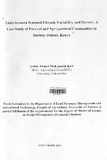| dc.description.abstract | This study was motivated by the need to ascertain whether poverty incidence, gap and
severity can vary with 'Seasonal climatic variability, and TO identify determinants of poverty
in sedentary agro-pastoral and semi-nomadic pastoral households. Data were collected
through formal interviews using a structured questionnaire in the Njernps Flats, a semi-arid
rangeland in the larger Baringo District (now Marigat and East POKotDistricts) of Kenya.
}\. total 1)1' 200 systematically selected households were interviewed, 125 practicing
sedentary agro-pastoralism and 75 semi-nomadic pastoralism.
The findings revealed that, unlike semi-nomadic pastoralists, sedentary agro-pastoralists
tend 10 -ii versify their sources 0f income by utilizing the available resources for different
economic activities. The analysis of poverty incidence, gap and severity using Pvalpha
equation indicated higher poverty levels in the study area during the wet and dry seasons.
Poverty level was found to be higher during the dry than the wet season. The Lorenz curves
demonstrated a big gap between the rich and poor in the same community on the one hand
and between the semi- nomadic pastoral ists and sedentary agro-pastoralists on the other
nand.
Tile OLS parametric estimates of the determinants of poverty indicated that the number of
livelihood sources, household size, distance to the nearest market, ownership of enclosures
and household herd size are the most important determinants of poverty in the study area.
The number of livelihood sources and ownership of enclosures were found to be positively
related to per capita daily income. Households that practiced crop cultivation were better
off compared to those which did not. Access to extension services and education level of
household heads were found to be positively related to per capita daily income in sedentary
agco-pastoral system. Distance to pasture and herd size were positively related to per capita
daily income in the semi-nomadic pastoral system. In contrast to the it priori expectation, a
negative relationship was observed between per capita daily income and household size in
both sedentary agro-pastoral households and semi-nomadic ones. Binary logistic model
results indicated the highest influence on poverty incidence as a result of change in relief
food quantity in semi-nomadic households. In addition, access to extension services and
remittances were found to be the most significant determinants of poverty incidence under
semi-nomadic pastoral land use system. Under sedentary agro-pastoral land use system,
XlI
however, it was the number of livelihood sources followed by the education of the
household head that had the highest effect on poverty incidence.
This study demonstrated that poverty incidence, severity and depth vary with seasonal
climatic variability. Sedentary agro-pastoralists were found to be wealthier than seminomadic
pastoralists. This was partly attributed to more diversification of economic
activities among sedentary agro-pastoralists compared to the semi-nomadic pastoralists.
Diversification of household livelihoods through off-farm activities can therefore be
recommended as a way of reducing poverty in semi-arid rangelands. Furthermore, the
study recommends family planning and birth control to reduce the number of people
directly .dependent on pastoral livelihood. Reversing the current trends in seasonal
fluctuations in poverty status of pastoral households can therefore be achieved through
provision. of sustainable altemative livelihood sources. This will reduce over-reliance on
livestock and land as the primary sources of livelihood. | en |

